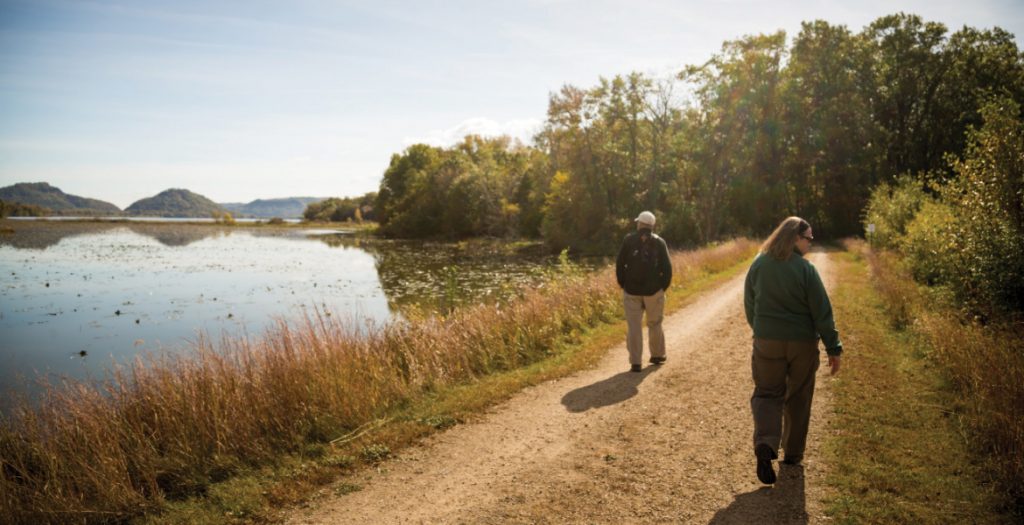By Kevin Revolinski | Photo courtesy Travel Wisconsin
With two Great Lakes and the Mississippi River, as well as abundant varied and healthy habitats throughout the state, birding in Wisconsin can be a spectacular pastime. September is best for viewing, but many species still travel in October. Here are five of the best spots to catch glimpses of the event.
HORICON MARSH
National and state wildlife refuges combine to form the over 32,000 acres of this marsh and make up the largest freshwater cattail marsh in the U.S. Each fall more than one million birds pass through here, including 200,000 Canada geese and many species of waterfowl and songbirds. Trails, observation platforms and boardwalks cater to visitors. W4279 Headquarters Rd., Mayville
While You’re There: In addition to each refuge’s exhibit-filled visitor’s centers, check out the Marsh Haven Nature Center, or bike the Wild Goose State Trail, which passes along the marsh.
CREX MEADOWS
An ongoing restoration project to bring back its brush prairie-wetlands environment, this 30,000-acre state wildlife area is a Globally Important Bird Area. Crex has a large population of sandhill cranes and up to 8,000 are present during migration, along with thousands of snow geese, coots, ducks and bald eagles. A 24-mile driving tour explores the property. 102 Crex Ave., Grantsburg
While You’re There: Hikers will appreciate the 40 miles of trails in Governor Knowles State Forest, which also offers camping. Paddlers may opt for a day trip down the stream.
TREMPEALEAU NATIONAL WILDLIFE REFUGE
This 6,226-acre property is directly on the Mississippi River migration route and offers routes for walking, biking and vehicles through marshland and bottomland forest, as well as along open water. Expect a variety of water birds including swans, herons, geese, gulls, terns, grebes and even eagles. W28488 Refuge Rd., Trempealeau
While You’re There: Nearby Perrot State Park serves campers and is itself good for wildlife observation. The Historic Trempealeau Hotel is the place for a meal and its legendary walnut burger.
SANDHILL WILDLIFE AREA
As the name suggests, sandhill cranes are common here, and more than 1,500 pass through in fall. However, the 9,150-acre preserve was named for sandy ridges left behind by the now-extinct Glacial Lake Wisconsin that melted and drained at the end of the Ice Age. Cranes arrive in September but may linger as late as November. The 3,000-acre Gallagher Marsh also attracts a variety of waterfowl and forested areas see songbirds. 1715 County Highway X, Babcock
While You’re There: Check out the arts and crafts (and the namesake harvest) at the annual Warrens Cranberry Fest (Sept. 24-26), or find more birding opportunities at Necedah National Wildlife Refuge.
SCHLITZ AUDUBON NATURE CENTER
Don’t knock urban birding. With six miles of trails through 185 acres of prairie, wetlands, woods and Lake Michigan shoreline, this birding hotspot on the north side of Milwaukee is magnificent. Myriad species of warblers — including the blackpoll warbler on its 7,000-mile journey — head south in August and September, while broad-winged hawks may be seen in groups of hundreds in October. 1111 E. Brown Deer Rd., Milwaukee
While You’re There: Less than 20 minutes north, also along the big lake, is Lion’s Den Gorge Nature Preserve, with gorgeous lake views and varied habitats for feathered travelers.
INTERNATIONAL CRANE FOUNDATION
Cranes are some of the most majestic and magnificent birds in the world, with their long, elegant necks and intriguing dances. Of the 15 species, only two are native to North America and 11 are threatened with extinction. But just outside Baraboo, you can see every one of them at the International Crane Foundation (ICF). Founded in 1973 by a couple of passionate ornithology students, and with the support of a local family who rented their horse farm to them annually for a dollar, the ICF grew to include experts in 50 countries and created a nearly 300-acre wildlife center with habitats for nearly 100 birds. Among them is the extremely rare whooping crane.
The facility underwent a $10 million renovation in 2018, and because of the pandemic, the ICF just recently started welcoming visitors back. The new Cranes of the World exhibition has expanded habitats with natural ponds, paved pathways and fence-free viewing areas. The ICF also boasts indoor exhibits,
a theater and guided tours. The center is open May through October, and admission is free, if you become an ICF member of the foundation. savingcranes.org

